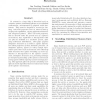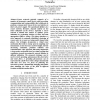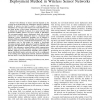230 search results - page 31 / 46 » Movement Recognition Using Body Area Networks |
COLCOM
2005
IEEE
14 years 1 months ago
2005
IEEE
In contrast to a large body of theoretical work on computer systems, distributed systems are not idealised constructions, unconstrained by physical world limitations. They must be...
COMSWARE
2006
IEEE
14 years 1 months ago
2006
IEEE
Sensor networks typically comprise of a number of inexpensive small devices with processing, communication and sensing abilities that collaborate to perform a common task. Sensor d...
INFOCOM
2005
IEEE
14 years 1 months ago
2005
IEEE
— The efficiency of sensor networks depends on the coverage of the monitoring area. Although in general a sufficient number of sensors are used to ensure a certain degree of re...
ACMSE
2006
ACM
14 years 1 months ago
2006
ACM
: There is a growing interest in deployment and evaluation of routing protocols for Vehicular Ad-Hoc Wireless Networks (VANETs) in urban contexts. The mobility model of nodes is on...
ICASSP
2011
IEEE
12 years 11 months ago
2011
IEEE
Speech inversion is a way of estimating articulatory trajectories or vocal tract configurations from the acoustic speech signal. Traditionally, articulator flesh-point or pellet t...




